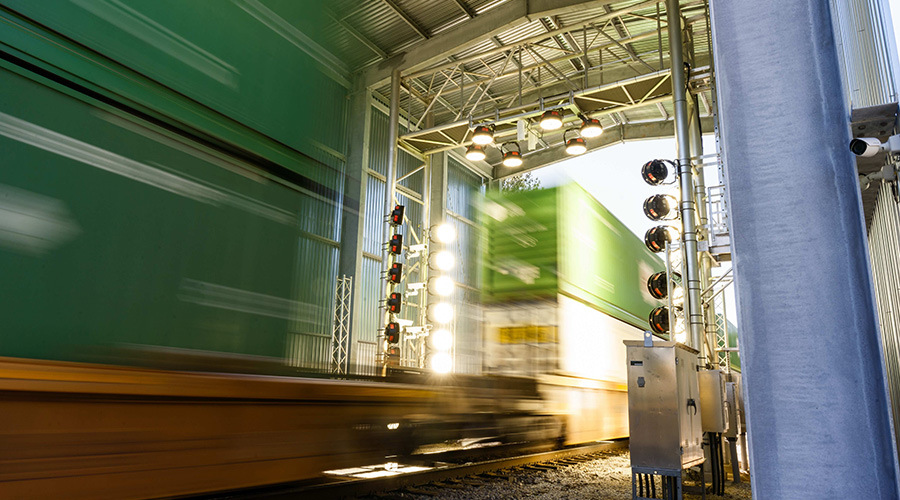BNSF combines AI, algorithm and machine learning to automate rail-car switching
2/14/2024
By Jeff Stagl, Managing Editor
During the pandemic, Starbucks encountered a huge spike in the number of customers who ordered coffees and other drinks via mobile applications. That trend exponentially boosted the customization of orders, which led to many more drink combinations.
How many possible combos? About 383 billion — a barista nightmare.
Railroads also face a dizzying number of possible combinations when switching merchandise rail cars in a classification yard. For example, if a four-track yard held 10 cars that needed to be switched into three separate trains, there would be 5.2 million possible switching combinations. And there is only one optimal switch list.
Historically, railroads have relied on a highly experienced employee to create the switch list by sifting through myriad car-switching combinations, deciding on the best ones and hand-marking track numbers on the list. But the chances of it being the most optimal switch list aren’t high.
That’s why BNSF Railway Co. last year began to seek a better mousetrap — and ultimately found one the Class I believes is a game changer with merchandise car switching. BNSF yard planners, switch crews and data scientists developed a concept that incorporates artificial intelligence (AI) and machine learning techniques to create an algorithmically planned and optimized list for cars needing to be switched.
The AI optimization technology helps vastly reduce the time needed to determine a switch list. Instead of an employee taking a half hour to an hour to complete a list, an algorithm computes an optimal one in two minutes. The computing time is expected to eventually drop to 10 seconds.
Since the algorithm is tapped into the railroad’s operating platforms, it analyzes a list against all rules to verify that train makeup compliance requirements are followed, says Jon Gabriel, BNSF’s vice president of network strategy, design and innovation.
“It looks at all of our local subdivision-specific territory rules and restrictions to make sure that we build a good quality and safe train that reduces the exposure to both to our employees and the community,” he says.
Enhancing human decision-making and reducing variability from the switching process helps ease operational complexity and improve service consistency. That will enable BNSF to pursue more freight.
“We've always called switching an art. It’s actually a science and an algorithm,” says Gabriel. “You put [this] into a really complex solution and a complex operation that has really given us what I think is the future of real switching.”
The concept also helps create more capacity in classification yards.
 Located in Kansas City, Kansas, the 780-acre Argentine Yard is BNSF’s largest classification yard for merchandise traffic. The railroad expects to implement the switching concept there within 18 months. BNSF Railway Co.
Located in Kansas City, Kansas, the 780-acre Argentine Yard is BNSF’s largest classification yard for merchandise traffic. The railroad expects to implement the switching concept there within 18 months. BNSF Railway Co.“I would say this is a growth story. By moving the cars through our merchandise yards more fluidly with less handlings, it creates capacity for us to grow,” says Gabriel.
Moreover, the technology helps boost safety, too.
“These are big, heavy pieces of metal and the less times we have to touch these cars and switch them unnecessarily by putting all the right cars in the right place in the most efficient manner certainly reduces those extra work events,” says Gabriel.
First, the Texas trifecta
For the past three months, BNSF has been employing the concept at its Alliance Yard in Haslet, Texas, north of Fort Worth. The Class I also is evaluating the technology at the yard, which typically is used to build 100-car trains on four or five tracks.
“We are ironing out the numbers,” says Gabriel.
BNSF has 200 classification yards — each of which typically has unique characteristics — and the goal is to implement the concept at all of them over the next 18 months. The next targets, which are pegged for implementation by midyear: yards in Amarillo and Temple, Texas,
“Then we’ll have our three big yards in Texas taken care of. Those are very complex and very different yards,” says Gabriel.
BNSF has a patent pending on the concept, which — in addition to artificial intelligence — incorporates GIS mapping so yard managers know exactly where each switch is, what the routes are, how long each route is and how they connect.
The concept is used in the same way that switch-list makers are accustomed to, says Gabriel. Overall, it's the latest example of BNSF’s technological pursuits to boost productivity and efficiency.
Serving as a solution to some operational complexity and consistency, the concept placed BNSF in a similar parallel to Starbucks, says Gabriel. Only the objects being handled differ greatly.
“Instead of cups of coffee, it’s 140-ton rail cars that you’re passing around,” he says. “That really was the inspiration [for this].”

